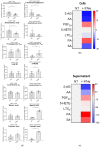Targeted Mass Spectrometry Reveals Interferon-Dependent Eicosanoid and Fatty Acid Alterations in Chronic Myeloid Leukaemia
- PMID: 37958498
- PMCID: PMC10649737
- DOI: 10.3390/ijms242115513
Targeted Mass Spectrometry Reveals Interferon-Dependent Eicosanoid and Fatty Acid Alterations in Chronic Myeloid Leukaemia
Abstract
Bioactive lipids are involved in cellular signalling events with links to human disease. Many of these are involved in inflammation under normal and pathological conditions. Despite being attractive molecules from a pharmacological point of view, the detection and quantification of lipids has been a major challenge. Here, we have optimised a liquid chromatography-dynamic multiple reaction monitoring-targeted mass spectrometry (LC-dMRM-MS) approach to profile eicosanoids and fatty acids in biological samples. In particular, by applying this analytic workflow to study a cellular model of chronic myeloid leukaemia (CML), we found that the levels of intra- and extracellular 2-Arachidonoylglycerol (2-AG), intracellular Arachidonic Acid (AA), extracellular Prostaglandin F2α (PGF2α), extracellular 5-Hydroxyeicosatetraenoic acid (5-HETE), extracellular Palmitic acid (PA, C16:0) and extracellular Stearic acid (SA, C18:0), were altered in response to immunomodulation by type I interferon (IFN-I), a currently approved treatment for CML. Our observations indicate changes in eicosanoid and fatty acid metabolism, with potential relevance in the context of cancer inflammation and CML.
Keywords: bioactive lipids; cancer inflammation; cancer metabolism; chronic myeloid leukaemia; eicosanoids; fatty acids; innate immunity; lipidomics; mass spectrometry; type I interferon response.
Conflict of interest statement
The authors declare no conflict of interest.
Figures




Similar articles
-
Analysis of cytochrome P450 metabolites of arachidonic acid by stable isotope probe labeling coupled with ultra high-performance liquid chromatography/mass spectrometry.J Chromatogr A. 2015 Sep 4;1410:154-63. doi: 10.1016/j.chroma.2015.07.100. Epub 2015 Jul 29. J Chromatogr A. 2015. PMID: 26253834
-
The plasma lipidome in acute myeloid leukemia at diagnosis in relation to clinical disease features.BBA Clin. 2017 Mar 8;7:105-114. doi: 10.1016/j.bbacli.2017.03.002. eCollection 2017 Jun. BBA Clin. 2017. PMID: 28331812 Free PMC article.
-
LC-MS/MS method for rapid and concomitant quantification of pro-inflammatory and pro-resolving polyunsaturated fatty acid metabolites.J Chromatogr B Analyt Technol Biomed Life Sci. 2013 Aug 1;932:123-33. doi: 10.1016/j.jchromb.2013.06.014. Epub 2013 Jun 15. J Chromatogr B Analyt Technol Biomed Life Sci. 2013. PMID: 23831705
-
Liquid chromatography-tandem mass spectrometry analysis of eicosanoids and related compounds in cell models.J Chromatogr B Analyt Technol Biomed Life Sci. 2014 Aug 1;964:41-9. doi: 10.1016/j.jchromb.2014.05.024. Epub 2014 May 24. J Chromatogr B Analyt Technol Biomed Life Sci. 2014. PMID: 24932539 Review.
-
Targeted chiral lipidomics analysis of bioactive eicosanoid lipids in cellular systems.BMB Rep. 2009 Jul 31;42(7):401-10. doi: 10.5483/bmbrep.2009.42.7.401. BMB Rep. 2009. PMID: 19643036 Free PMC article. Review.
References
-
- Lindqvist H.M., Winkvist A., Gjertsson I., Calder P.C., Armando A.M., Quehenberger O., Coras R., Guma M. Influence of Dietary n-3 Long Chain Polyunsaturated Fatty Acid Intake on Oxylipins in Erythrocytes of Women with Rheumatoid Arthri-tis. Molecules. 2023;28:717. doi: 10.3390/molecules28020717. - DOI - PMC - PubMed
-
- Cipollone F., Mezzetti A., Fazia M.L., Cuccurullo C., Iezzi A., Ucchino S., Spigonardo F., Bucci M., Cuccurullo F., Prescott S.M., et al. Association between 5-lipoxygenase expression and plaque instability in humans. Arter. Thromb. Vasc. Biol. 2005;25:1665–1670. doi: 10.1161/01.ATV.0000172632.96987.2d. - DOI - PubMed
MeSH terms
Substances
LinkOut - more resources
Full Text Sources
Medical

